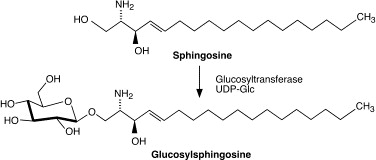Glucosylsphingosine Analysis Service
What is Glucosylsphingosine?
Glucosylsphingosine (GlcSph) is a vital lipid molecule that plays a significant role in numerous biological processes. Also referred to as a glucosylceramide metabolite or derivative, GlcSph consists of a glucose moiety (glucose) and a sphingosine backbone. It serves as a crucial component of sphingolipids, a class of lipids that are essential for diverse cellular functions.
The synthesis of GlcSph occurs through the action of the enzyme glucosylceramide synthase. This enzyme adds a glucose molecule to ceramide, resulting in the formation of GlcSph. Subsequently, GlcSph undergoes further metabolism by the enzyme glucosylceramidase, leading to the production of glucose and sphingosine.

Understanding the biological mechanisms and functions of GlcSph is of utmost importance for unraveling its involvement in various physiological and pathological processes. GlcSph has been implicated in critical cellular activities such as cellular signaling, maintenance of membrane stability, and regulation of lipid metabolism. Consequently, GlcSph presents an intriguing molecule for analysis.
By studying GlcSph, researchers can gain valuable insights into its participation in essential cellular processes, including cell growth, differentiation, and apoptosis. Furthermore, GlcSph analysis provides a wealth of information for investigating its role in lipid-mediated diseases and exploring potential therapeutic interventions.
Glucosylsphingosine Lipid Analysis in Creative Proteomics
Creative Proteomics, a leading provider of advanced lipidomics services, offers comprehensive GlcSph analysis solutions to researchers worldwide. With state-of-the-art instrumentation, a highly skilled team of scientists, and a commitment to quality, Creative Proteomics ensures accurate and reliable GlcSph analysis results. The services provided include:
Quantification of Glucosylsphingosine: Accurate quantification of GlcSph levels using advanced LC-MS or HPLC techniques.
Lipid Profiling: Comprehensive lipid profiling, including the identification and quantification of GlcSph and related lipid species.
Structural Elucidation: In-depth analysis of GlcSph may involve structural elucidation of its associated lipid species. Advanced mass spectrometry techniques, such as tandem MS (MS/MS) and high-resolution MS, enable the determination of lipid structures, including acyl chain composition and double bond positions.
Data Analysis and Interpretation: Creative Proteomics provides comprehensive data analysis and interpretation, assisting researchers in deriving meaningful insights from GlcSph analysis results.
Glucosylsphingosine Analysis Platforms and Instrumentation
To conduct comprehensive Glucosylsphingosine analysis, advanced platforms and state-of-the-art instruments are employed. The choice of platform depends on the specific research goals, sample type, and desired analytical parameters. Some commonly used platforms and instruments for GlcCer analysis include:
Liquid Chromatography-Mass Spectrometry (LC-MS):
- Instrument Model: Agilent 1290 Infinity LC system coupled with Agilent 6495 Triple Quadrupole Mass Spectrometer.
- Features: This system provides high separation power and sensitivity for quantification, identification, and structural characterization of GlcSph.
Gas Chromatography-Mass Spectrometry (GC-MS):
- Instrument Model: Thermo Scientific Trace 1310 GC system coupled with Thermo Scientific ISQ QD Mass Spectrometer.
- Features: This system is suitable for analyzing volatile and derivatized lipids, offering high sensitivity for quantification and characterization of fatty acids and their derivatives.
High-Performance Liquid Chromatography (HPLC):
- Instrument Model: Waters Acquity H-Class UPLC system coupled with Waters ACQUITY QDa Mass Spectrometer.
- Features: This system offers high sensitivity and rapid separation capabilities for the quantification of GlcSph.
Applications of Glucosylsphingosine Analysis
Cellular Signaling and Membrane Function Research: GlcSph plays a crucial role in cellular signaling pathways, particularly those involved in cell growth, differentiation, and apoptosis. Analyzing GlcSph allows researchers to gain insights into its precise involvement in these processes, unravel the regulation of cellular functions, and understand the intricate interplay between lipids and cellular signaling.
Lipid Metabolism Research: GlcSph analysis is an essential component of lipidomics research, which aims to comprehensively study the composition and dynamics of lipids within biological systems. By quantifying GlcSph levels and profiling other lipids, researchers can unravel lipid metabolic pathways, identify lipid biomarkers, and gain a deeper understanding of how lipids impact cellular functions and overall metabolism.
Metabolic Disorders: GlcSph analysis is pivotal in studying metabolic disorders associated with altered lipid metabolism. By analyzing GlcSph levels in samples from individuals with metabolic diseases, researchers can gain insights into disease progression, identify potential diagnostic biomarkers, and evaluate the effectiveness of therapeutic interventions targeting lipid dysregulation.
Neurodegenerative Diseases: GlcSph has been implicated in neurodegenerative disorders such as Parkinson's disease and Alzheimer's disease. GlcSph analysis enables researchers to investigate its role in neuronal dysfunction, oxidative stress, and neuroinflammation, providing critical insights for developing targeted therapies and interventions for neurodegenerative conditions.
Drug Development: GlcSph analysis proves valuable in drug development and preclinical studies. By assessing GlcSph levels in response to drug treatments, researchers can evaluate the efficacy of potential therapeutic agents, determine optimal dosages, and gain a deeper understanding of the underlying mechanisms of action, including drug-induced alterations in lipid metabolism.
Biomarker Discovery: GlcSph analysis contributes to the identification of lipid biomarkers associated with specific diseases or pathological conditions. By studying GlcSph levels in different samples, researchers can explore its potential as a diagnostic or prognostic biomarker, providing valuable insights for disease detection, monitoring, and personalized medicine approaches.
If you have any questions about our glucosylsphingosine analysis services, please contact us.
* Our services can only be used for research purposes and Not for clinical use.
Services:


